Conducting Clinical Trials in Asia
Rapid recruitment, potential cost savings, and investigative sites are just a few of the factors attracting sponsors to the region.
There are three key clinical development regions in Asia, namely India, China, and South East Asia. Each of these regions offers similar attractions and poses similar questions with respect to the placement of global clinical trials.
The similarities between the regions are the attractions of rapid patient recruitment driven by large patient populations with diseases of both the developed and developing world and fewer competitor trials as compared to North America and Europe. In addition, there could be a substantial potential for cost savings as well as the opportunity to penetrate some of the fastest growing pharmaceutical markets in the world.
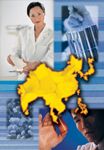
Photography: Comstock Illustration: Paul A. Belci
Regulatory approvals process
Although regulatory approval timelines are longer in Asia as compared to North America, they are the most prolonged and uncertain in China. In Singapore and Korea, regulatory processes are the most streamlined, quick, and predictable.
Regulatory approval in China for clinical trial initiation may take up to nine months as the approvals dossier navigates its path through six regulatory approval bodies, as shown in Table 1. The potential for delay at any one of these bodies contributes to the unpredictability of the process. Factoring in this lengthy regulatory approval process is essential while planning clinical trials in China. A thorough understanding of the local regulatory requirements is necessary to ensure that the dossiers are correctly assembled to keep delays to a minimum.
Korea is positioned at the other end of the spectrum, with its regulatory processes streamlined such that the Korea Food and Drug Administration (KFDA) is able to deliver approval for a clinical trial application within 30 working days. Furthermore, the Institutional Review Board (IRB) approval process occurs in parallel.
In Singapore, the average regulatory approval period is four weeks followed by an additional four to six weeks for site-level IRB/ethics committee (EC) approval. In Hong Kong and Taiwan, parallel processing of regulatory and IRB/EC approval is possible and takes on an average eight and ten weeks, respectively, to obtain both approvals. This is followed by a further two week wait to obtain the license to import clinical trial supplies.
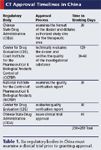
Table 1. Six regulatory bodies in China must examine a clinical trial prior to granting approval.
Over the past two years, the regulatory approvals process in India has become progressively more streamlined, with median approval times reduced from 16 to 10 weeks. Approval from local ECs at the site level is processed in parallel. If biological clinical trial samples need to be exported, then additional approval from the Directorate General of Foreign Trade is required, a process that takes four to ten weeks. Because the Drugs Controller General of India (DCGI), driven by the increased volume of international clinical trial applications, has become more experienced and better resourced, the uncertainty regarding regulatory approval times has substantially diminished. This phenomenon will be notable in numerous emerging countries as their nascent clinical development environments become more mature with time.
Evolving intellectual property protection legislation
The local pharmaceutical industry in Asia has historically been dominated by generic pharmaceutical companies. Not surprisingly, therefore, innovative pharmaceutical sponsors have concerns about the protection of their intellectual property (IP) in these countries. However, IP protection legislation in Asia is evolving as a result of international pressure as well as domestic economic development.
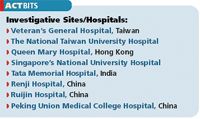
ACTBITS
India represents a good example of an Asian country that is embracing international IP protection legislation, with important consequences to both its local industry as well as its positioning in the global pharmaceutical industry. Historically, the Indian Patents Act (1970) that replaced British colonial laws related to intellectual property rights did not recognize pharmaceutical product patents. Instead, the manufacturing process patents were recognized for a seven-year period. Not surprisingly, this legislation enabled the growth of a domestic generic pharmaceutical industry. Winds of change were heralded when India agreed to uphold the WTO Trade-Related Intellectual Property Rights (TRIPS) agreement finalized during the Uruguay round of multilateral trade negotiations in 1995. As a signatory to the TRIPS Agreement, India is committed to recognize and enforce product patents in all fields of technology including pharmaceuticals. The Indian Government, DCGI, and the Indian pharmaceutical industry appear committed to fostering a life science innovation-based industry with the realization that robust IP protection is a prerequisite. Furthermore, India's growing software and entertainment companies continue to lobby for robust IP protection legislation capable of protecting the IP that they are generating. Legislation for the enforcement of IP protection was passed by the Indian Parliament in January 2005 in spite of protests from patient consumer groups—evidence that India's legal system has responded to both the external and internal drivers of change.
China has also declared a commitment to comply with TRIPS and has amended several IP related laws including the 1993 Patent Law in 2001, Implementing Rules in 2002, and more recently the copyright law. In addition, the enforcement of IP Rights has been strengthened such that there are stiff penalties for patent, trademark or copyright infringement; options to utilize preliminary injunctions; and criminal liability for trademark infringement. The drivers for these legislative changes are the recognition that strong intellectual property protection is necessary to attract foreign investment, protect indigenous IP, and facilitate alliances with international technology leaders.
Singapore has been ranked as the top Asian country for strong IP protection and legal enforcement by the World Economic Forum (WEF), the Institute for Management Development (IMD), and the Political Economic Risk Consultancy (PERC) three years in a row, from 2002 to 2004. This has contributed to the fact that in addition to clinical development, Western companies have established successful drug discovery alliances with both academic and commercial organizations in Singapore.
Looking ahead, the expectation for Asia is that both India and China will ultimately evolve their IP protection legislation and enforcement systems to the same standard as South East Asian countries. Meanwhile, however, sponsors remain wary about the protection of their IP in these countries and exercise cautions with respect to the nature of research activities they outsource or offshore.
Commercial market potential
China represents one of the fastest growing pharmaceutical markets in the world and is the most lucrative market in Asia. Today, China is the 7th largest pharmaceutical market in the world in revenue terms, valued at approximately 14 billion USD in 2005. In the next five years, this market is expected to grow by another 10 billion USD. The driver for this rapid growth is a population of 1.33 billion that is expected to substantially increase its consumption of Western pharmaceutical products. China has 160 million people over the age of 60, which is expected to increase to 280 million by 2025. The per capita drug expenditure in China is 12 USD, which equals only 2% of that in the United States. Urbanization and increasing affluence is expected to result in an exponential growth from this modest baseline. Furthermore, large-scale conversion from the exclusive use of Traditional Chinese Medicine would augment the sale of pharmaceuticals based on Western medicine. Hence, not surprisingly, most large pharmaceutical companies have a major presence in China and are seeking to continually augment their sales efforts.
It is worth noting that the widespread concomitant use of Traditional Chinese Medicines with Western pharmaceutical products represents a challenge with respect to clinical trial design and interpretation of trial data, as the effect, if any, of drug interaction remains to be delineated.
The commercial value of the Indian market is presently miniscule in value, but is large in volume and growth potential. In volume terms, it is the world's fourth largest market in unit sales, but ranks 13th in value terms with an annual revenue of approximately 5 billion USD. It remains a highly fragmented market, with Indian companies enjoying 70% of the total market share and the leading player having only a 7% market share. The biotechnology market is worth about 1 billion USD and is enjoying high growth driven by exports and domestic vaccine sales. The present per capita pharmaceutical expenditure is only 4.50 USD, providing a modest base for future growth. India's middle income group is comprised of 300 million, which is increasing both in number and affluence, and represents an attractive market. This is especially true with the relaxation of price controls that is expected to result from changes in the domestic generic industry.
Korea represents another high growth Asian market—the Korean pharmaceutical market is estimated to be worth 5.6 billion USD and has grown on average 8% annually for the past five years, outpacing the growth in the global market. The Korean pharma market has continued to experience restructuring since 1999, when the Korean Government implemented initiatives to improve the cost effectiveness of health care. The implemented initiatives that have had a significant impact on the pharmaceutical market are: Separation of Prescribing and Dispensing (SPD), Actual Transaction Pricing (ATP), and the A-7 policy of pricing innovative drugs at international prices. These initiatives have improved transparency in the reimbursement system and have facilitated the positioning of multinational pharmaceutical companies' innovative drugs in the domestic marketplace. There have also been positive changes in the regulatory climate that have allowed smoother and earlier market access for new, innovative drugs. This, however, is counter balanced by the drive to fix lower drug prices and promote the use of generics by the financially constrained Korean health care and insurance system.
Reliable data quality
Clinical trial data from all Asian countries has now been accepted by international regulatory authorities for pivotal studies. An FDA audit of clinical sites within a country is triggered by the presentation of a certain amount of data to the authority from that country and clinical site. Thus, the occurrence of the first FDA audit serves as an indicator of the extent of global clinical trial activity in a country. The FDA has audited the National Cheng Kung University Hospital and Tri-Service General Hospital in Taipei and the Queen Mary Hospital in Hong Kong with no significant finding. The first FDA audit did not take place in India until mid-2005 when two sites in Southern India participating in a global infectious disease trial were audited by FDA inspectors with no findings. China is yet to receive its first U.S. FDA audit.
Generally, sponsors have been satisfied with the quality of clinical data provided by clinical trial sites in Asia in spite of the relatively nascent clinical development environments. An important reason for this is the availability of numerous hospitals well suited to serve as investigative sites. The vast majority of specialty care in Asia is provided by state-funded general hospitals. The university teaching hospitals have state-of-the-art facilities and technologies with thousands of inpatient beds to provide diagnostic, therapeutic, and support services in all major therapeutic areas. It is at sites like these that the majority of clinical research in Asia is conducted. There are over 17, 10, and 6 such hospitals in Taiwan, Malaysia, and Singapore, respectively.
Veteran's General Hospital in Taipei, Taiwan, is a multidisciplinary specialist center with 440 attending specialists, over 500 resident doctors, and 300 beds. In 2005, 2.5 million patients attended the outpatient clinics and 1 million received inpatient care. Various specialists at this hospital have served as clinical trial investigators, and in order to facilitate this activity the hospital has its own ethics committee. The National Taiwan University Hospital is Taiwan's premier teaching hospital and leading medical center. Since its establishment in 1897, the institution has trained more than 10,000 physicians. Presently, 840 students are enrolled in medical and other related programs. The 4000 staff serve approximately 2000 inpatients and 7000 outpatients daily.
Queen Mary Hospital (QMH) is the teaching hospital of the medical school of The University of Hong Kong, with about 1400 beds. This center provides acute and specialist services to a population of about 1.5 million on Hong Kong Island. Not dissimilar is Singapore's National University Hospital—a 930-bed acute and specialist hospital.
Tata Memorial Hospital in Mumbai, India, is an example of a specialty oncology center that is very well suited to participate in global clinical development. Each year, 25,000 cancer patients visit this hospital, not only from India but also from neighboring countries. Each day, 1000 patients attend out-patient clinics and there are 441 inpatient beds. Over 10,000 major operations are performed at Tata Memorial Hospital, and about 5000 radiotherapy and chemotherapy treatments are delivered each year. The center is equipped with state-of-the-art facilities, including spiral CT scanner, gamma cameras, linear accelerator, and bone marrow transplant facilities. In order to coordinate the ever increasing interest from international and domestic sponsors, a Clinical Research Secretariat, Scientific Review Committee, and Ethics Committee have been established.
China, too, has numerous hospitals with the potential to participate in global clinical trials. Renji Hospital and its extension in Pudong Shanghai is a teaching hospital with a campus space of over 56,067 square meters, 1000 patient beds, and 2300 staff—among them 221 senior doctors. Ruijin Hospital is another general teaching hospital in Shanghai with 1385 patient beds and 3242 staff, including 367 senior doctors. Numerous clinical trials are being presently conducted at Peking Union Medical College Hospital, which is upgrading some of its facilities to be better able to serve the needs of international sponsors seeking to execute their clinical trials in China. This institution was founded by the Rockefeller Foundation and is one of the six hospitals included within the prestigious Chinese Academy of Medical Sciences, China's premier nation-wide medical science research institution.
Availability of these types of world-class investigational sites in Asia enables rapid patient recruitment. Furthermore, there are numerous well-trained and motivated investigators supported by their clinical research teams comprised of resident physicians and nurses. It is these factors that enable the provision of high-quality and timely clinical data from Asia.
Availability of experienced staff
Clinical trial execution is a labor-intensive and process-driven activity, hence access to suitable resources remains an important prerequisite. English-speaking, motivated work forces are well suited to meet the needs of the clinical development sector. Most of the region's leading specialists have received postgraduate medical training in the United States or United Kingdom. Although the level of experience is variable in the labor market (see Table 2 for a comparison of experience level and other key factors), there are numerous training initiatives arranged by state and private organizations that attempt to teach candidates with a biomedical background the principles of GCP-compliant clinical research.
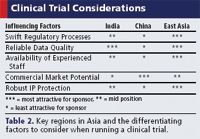
Table 2. Key regions in Asia and the differentiating factors to consider when running a clinical trial.
Retaining trained resources, however, is becoming a serious challenge in India—a reflection of the growing clinical development sector that is providing many opportunities for trained clinical research personnel.
Opportunities for cost savings
Cost savings from including Asia in global clinical trials could be substantial, resulting from a combination of the following factors. Investigator and site fees are approximately one-half of those in the United States. Further costs to the sponsor for providing trial-related medication, investigations, and hospitalization could be as low as 30% of those in America. Domestic travel costs for monitoring sites are lower because of the concentration of sites in the major cities and comparatively less costly fares and tariffs. Support services such as printing, translation, and local courier fees are also less expensive. Although the cost of labor is less, it is mandatory to make investments in training and support systems to ensure data quality.
Clinical data management
It would be remiss not to highlight the compelling case for conducting data management in India for global studies, i.e., not only studies conducted in India. Access to a large resource pool with IT and business process skills in a low-cost labor environment provide the basis for cost-effective data management services. Furthermore, excellent English language skills, large numbers of IT-literate biomedical graduates, and a motivated and flexible work ethic contribute to the attractiveness of this proposition. Prevalent high-speed Internet connectivity and absence of the biases stemming from the use of legacy systems make countries like India ideally positioned for the widespread adoption of EDC technologies.
Conclusion
In order to leverage the opportunities in Asia for timely, quality, and cost-effective clinical development in a risk-controlled fashion, sponsors must have access to the following capabilities: knowledge of local regulatory processes, relationships with local physicians and medical centers, understanding of the requirements of international regulatory authorities, and application of international standards to the local clinical research environments. Then, sponsors would be able to select countries in Asia best suited to meet their clinical development objectives with minimal risks. Sponsors who lack the above capabilities can access them with the assistance of contract research organizations (CROs). Many of the world's leading global CROs have developed operations in Asia to meet this need.
Nermeen Varawalla, MD, PhD, MBA, is vice president business development international with PRA International, Pacific House, Imperial Way, Worton Grange, Reading, Berkshire RG2 OTD, United Kingdom, +44 118 918 1025, fax +44 118 918 1001, email: varawallanermeen@praintl.com
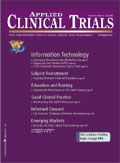
FDA Fast Tracks Johnson & Johnson’s Nipocalimab for Fetal Neonatal Alloimmune Thrombocytopenia
March 27th 2024Johnson & Johnson is moving forward with a pair of Phase III trials of nipocalimab to reduce the risk of fetal neonatal alloimmune thrombocytopenia in alloimmunized pregnant patients.